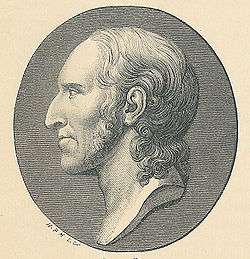Jörgen Zoega

Jørgen Zoëga (20 December 1755 – 10 February 1809) was a Danish archaeologist and numismatist; born at Daler near Tønder, near the west coast of northern Schleswig.
Biography
His father, whose family came originally from Northern Italy, was Vilhad Christian Zoëga, Protestant pastor of Møgeltønder; his mother was Henriette Clausen.
As a boy Jørgen was taught at home and then attended the gymnasium in Altona. He went in 1773 to the University of Göttingen and later to Leipzig, studying philosophy and the Classics. Repeated journeys to Italy developed an interest in archaeology, which had awakened early in him. In 1782, thanks to the Danish minister Ove Høegh-Guldberg, he received for two years a pension from the State. From Vienna, where he studied under the celebrated numismatist Eckhel, Zoëga went to Rome early in 1783. Through introductions he received here a kindly welcome from Stefano Borgia, then a prelate and later cardinal.

On his way home, Zoëga heard in Paris of the political overthrow of his patron Guldberg. He therefore returned to Rome and took up permanent abode in that city, which a man, as he said, should never see or else never leave. He had before this catalogued and exhaustively described Borgia's fine collection of coins; the prelate now gave him strong support and Pius VI granted him a pension of 400 scudi. With the aid of influential friends Zoëga also received permanent assistance from Denmark, and in 1790 was made an honorary member of the Academy of Art in Copenhagen. When his patron, Cardinal Borgia, was exiled from Rome in 1798, Zoëga, grateful for the cardinal's hospitality to Danes who had gone to Rome, obtained a pension for Borgia from the state revenues of Denmark.
From 1798 Zoëga was Danish consul at Rome and a member of the Academy of Sciences at Copenhagen. His work in numismatics led him to take up Egyptological and Coptic studies, which he conducted with success. By his power of penetration and sound judgment, he pointed out to later investigators the path to be followed in interpreting hieroglyphics.
In his work on Rosetta Stone, French scholar Silvestre de Sacy highlighted a suggestion made by Georg Zoëga in 1797 that the foreign names in Egyptian hieroglyphic inscriptions might be written phonetically. This proved to be a very fruitful insight that eventually led to decipherment.
Zoega is regarded as the associate of Winckelmann and Visconti in establishing scientific archaeology. His services to learning were also acknowledged in foreign countries by his election in 1806 to membership in the Academies of Science at Berlin and Vienna. He died in Rome three years later.
Zoega's most important works are:
- Nummi aegyptii imperatorii (Rome, 1787)
- De origine et usu obeliscorum (Rome, 1797)
- Bassorilievi antichi di Roma (2 vols., Rome, 1808), translated into German by Friedrich Gottlieb Welcker (1811)
- Catalogus codicum copticorum manuscriptorum, qui in museo Borgiano Velitris adservantu (Rome, 1810), a posthumous work.
He also wrote several treatises on classical archaeology, also translated into German by Welcker, Georg Zoegas Abhandlungen (Göttingen, 1817). A work on the topography of Rome was left unfinished in manuscript.
His brother was the botanist Johan Zoëga.
| Wikisource has the text of the 1913 Catholic Encyclopedia article Jörgen Zoega. |
![]() This article incorporates text from a publication now in the public domain: Herbermann, Charles, ed. (1913). "article name needed". Catholic Encyclopedia. New York: Robert Appleton.
This article incorporates text from a publication now in the public domain: Herbermann, Charles, ed. (1913). "article name needed". Catholic Encyclopedia. New York: Robert Appleton.
Further reading
- Daniela Williams, Bernhard Woytek "Zoëga studente di numismatica. Il soggiorno a Vienna (1782) e i contatti con Joseph Eckhel", in K. Ascani, P. Buzi, D. Picchi (eds) The Forgotten Scholar: Georg Zoëga (1755-1809). At the Dawn of Egyptology and Coptic Studies, Leiden - Boston 2015, pp. 101–110.
- Øjvind Andreasen (ed.), Georg Zoëga - Briefe und Dokumente, vol. I, Det Danske Sprog- og Litteraturselskab, Copenhagen, 1967. ISBN 87-7876-426-2.
- Øjvind Andreasen og Karen Ascani (eds.), Georg Zoëga - Briefe und Dokumente, vol. II-V, Det Danske Sprog- og Litteraturselskab, 2013. ISBN 978-87-7533-023-2.